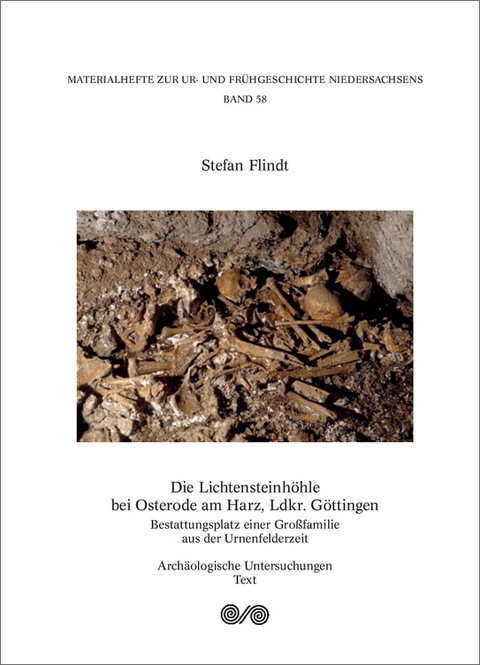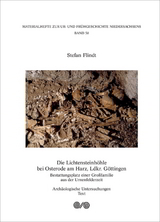Die Lichtensteinhöhle bei Osterode am Harz, Ldkr. Göttingen
Bestattungsplatz einer Großfamilie aus der Urnenfelderzeit. Archäologische Untersuchungen
Seiten
2022
|
1., Aufl.
VML Vlg Marie Leidorf (Verlag)
978-3-89646-850-5 (ISBN)
VML Vlg Marie Leidorf (Verlag)
978-3-89646-850-5 (ISBN)
Vorgelegt werden in diesem Band der Materialhefte zur Ur- und Frühgeschichte die archäologischen Forschungsergebnisse der langjährigen Ausgrabungen in der Lichtensteinhöhle bei Osterode am Harz [Bundesrepublik Deutschland, Bundesland Niedersachsen, Landkreis Göttingen]. Anhand des umfangreichen Fundinventars, darunter vor allem zahlreiche Reste von Keramikgefäßen und mehr als 200 Bronzeobjekte, kann dieser Fundplatz in das 10. – 9. Jahrhundert v.Chr. und damit einen jüngeren Abschnitt der Urnenfelderzeit datiert werden. Von besonderer Bedeutung für die Urnenfelderzeit-Forschung ist jedoch der Komplex von mehr 4.000 unverbrannten Menschenknochen, die ohne jeglichen anatomischen Verband in der Höhle aufgefunden wurden. Anhand umfangreicher genetischer Analysen ließen sich diese Skelettelemente 57 Individuen zuweisen, von denen 42 einem mindestens 4 – 5 Generationen umfassenden Familienclan mit vier genetisch eng verwandten Familiengruppen bilden. Anzahl und Zusammensetzung des menschlichen Knocheninventars sowie weitere Indizien lassen dabei kaum einen Zweifel daran, dass es sich bei den Knochenfunden in der Lichtensteinhöhle um sekundäre Deponierungen ausgewählter Skelettelemente handelt, und diese damit über fast ein Jahrhundert als Familiengruft fungiert hat. Erstmals kann damit für die Urnenfelderzeit ein regulär über einen längeren Zeitraum hinweg praktiziertes mehrphasiges Bestattungsbrauchtum mit Sekundärbestattungen in einer Höhle nachgewiesen werden. Das umfangreiche Fundinventar und die Vielzahl der Befunde aus der Lichtensteinhöhle“ gewähren darüber hinaus tiefe Einblicke in die begleitenden Begräbnisrituale und die Glaubensvorstellungen der urnenfelderzeitlichen Höhlennutzer, wie sie bisher für diese Epoche kaum möglich waren. Die Ergebnisse der umfangreichen naturwissenschaftlichen Untersuchungen u. a. zu den Menschenknochen und Tierknochen sowie den botanischen Makroresten, aber auch den Isotopenanalysen sollen zeitnah in einem Folgeband vorgelegt werden.
This volume of the Materialhefte zur Ur- und Frühgeschichte presents the results of a long-running archaeological excavation in the Lichtenstein cave near Osterode am Harz [Germany, state of Lower Saxony, district of Göttingen]. Based on the extensive finds assemblage, which amongst others comprises numerous remains of pottery vessels and more than 200 bronze objects, the site can be dated to the 10th-9th centuries B.C. and thereby to a younger part of the Urnfield Period. Particularly important for Urnfield Period research is the assemblage of more than 4.000 unburnt human bones, found in the cave without anatomical connection. Based on extensive aDNA analysis, these skeletal elements could be assigned to 57 individuals, 42 of whom form a biological kinship group spanning 4–5 generations and comprising four genetically closely related family units. The amount and composition of the human bone assemblage, alongside further indications, leave little doubt that the Lichtenstein cave bone material is the result of the secondary deposition of selected skeletal elements, and that the cave therefore functioned as a family tomb for almost a century. This is the first time that a regular multi-stage burial custom, practised over a longer period of time and involving secondary burial in a cave, has been documented for the Urnfield Period. In addition, the rich finds assemblage and the numerous features from Lichtenstein cave provide detailed insights into the accompanying funerary rites and the beliefs of the cave’s Urnfield Period users that significantly expand our understanding. The results of the extensive scientific analyses, amongst others focusing on the human and animal bone and the botanic macroremains, as well as the results of isotopic investigations, will be published shortly in a subsequent volume. This volume of the Materialhefte zur Ur- und Frühgeschichte presents the results of a long-running archaeological excavation in the Lichtenstein cave near Osterode am Harz [Germany, state of Lower Saxony, district of Göttingen]. Based on the extensive finds assemblage, which amongst others comprises numerous remains of pottery vessels and more than 200 bronze objects, the site can be dated to the 10th-9th centuries B.C. and thereby to a younger part of the Urnfield Period. Particularly important for Urnfield Period research is the assemblage of more than 4.000 unburnt human bones, found in the cave without anatomical connection. Based on extensive aDNA analysis, these skeletal elements could be assigned to 57 individuals, 42 of whom form a biological kinship group spanning 4–5 generations and comprising four genetically closely related family units. The amount and composition of the human bone assemblage, alongside further indications, leave little doubt that the Lichtenstein cave bone material is the result of the secondary deposition of selected skeletal elements, and that the cave therefore functioned as a family tomb for almost a century. This is the first time that a regular multi-stage burial custom, practised over a longer period of time and involving secondary burial in a cave, has been documented for the Urnfield Period. In addition, the rich finds assemblage and the numerous features from Lichtenstein cave provide detailed insights into the accompanying funerary rites and the beliefs of the cave’s Urnfield Period users that significantly expand our understanding. The results of the extensive scientific analyses, amongst others focusing on the human and animal bone and the botanic macroremains, as well as the results of isotopic investigations, will be published shortly in a subsequent volume.
This volume of the Materialhefte zur Ur- und Frühgeschichte presents the results of a long-running archaeological excavation in the Lichtenstein cave near Osterode am Harz [Germany, state of Lower Saxony, district of Göttingen]. Based on the extensive finds assemblage, which amongst others comprises numerous remains of pottery vessels and more than 200 bronze objects, the site can be dated to the 10th-9th centuries B.C. and thereby to a younger part of the Urnfield Period. Particularly important for Urnfield Period research is the assemblage of more than 4.000 unburnt human bones, found in the cave without anatomical connection. Based on extensive aDNA analysis, these skeletal elements could be assigned to 57 individuals, 42 of whom form a biological kinship group spanning 4–5 generations and comprising four genetically closely related family units. The amount and composition of the human bone assemblage, alongside further indications, leave little doubt that the Lichtenstein cave bone material is the result of the secondary deposition of selected skeletal elements, and that the cave therefore functioned as a family tomb for almost a century. This is the first time that a regular multi-stage burial custom, practised over a longer period of time and involving secondary burial in a cave, has been documented for the Urnfield Period. In addition, the rich finds assemblage and the numerous features from Lichtenstein cave provide detailed insights into the accompanying funerary rites and the beliefs of the cave’s Urnfield Period users that significantly expand our understanding. The results of the extensive scientific analyses, amongst others focusing on the human and animal bone and the botanic macroremains, as well as the results of isotopic investigations, will be published shortly in a subsequent volume. This volume of the Materialhefte zur Ur- und Frühgeschichte presents the results of a long-running archaeological excavation in the Lichtenstein cave near Osterode am Harz [Germany, state of Lower Saxony, district of Göttingen]. Based on the extensive finds assemblage, which amongst others comprises numerous remains of pottery vessels and more than 200 bronze objects, the site can be dated to the 10th-9th centuries B.C. and thereby to a younger part of the Urnfield Period. Particularly important for Urnfield Period research is the assemblage of more than 4.000 unburnt human bones, found in the cave without anatomical connection. Based on extensive aDNA analysis, these skeletal elements could be assigned to 57 individuals, 42 of whom form a biological kinship group spanning 4–5 generations and comprising four genetically closely related family units. The amount and composition of the human bone assemblage, alongside further indications, leave little doubt that the Lichtenstein cave bone material is the result of the secondary deposition of selected skeletal elements, and that the cave therefore functioned as a family tomb for almost a century. This is the first time that a regular multi-stage burial custom, practised over a longer period of time and involving secondary burial in a cave, has been documented for the Urnfield Period. In addition, the rich finds assemblage and the numerous features from Lichtenstein cave provide detailed insights into the accompanying funerary rites and the beliefs of the cave’s Urnfield Period users that significantly expand our understanding. The results of the extensive scientific analyses, amongst others focusing on the human and animal bone and the botanic macroremains, as well as the results of isotopic investigations, will be published shortly in a subsequent volume.
| Erscheinungsdatum | 25.01.2023 |
|---|---|
| Reihe/Serie | Materialhefte zur Ur- und Frühgeschichte Niedersachsens ; 58 |
| Verlagsort | Rahden/Westf. |
| Sprache | deutsch |
| Maße | 210 x 297 mm |
| Gewicht | 8770 g |
| Einbandart | gebunden |
| Themenwelt | Geschichte ► Allgemeine Geschichte ► Mittelalter |
| Schlagworte | Bestattungshöhle • Bronzekreis Mittelsaale • Genanalyse • Hakenspiralen • Kulthöhle • Migration • Sekundärbestattung • Unstrutgruppe • Urnenfelderzeit |
| ISBN-10 | 3-89646-850-2 / 3896468502 |
| ISBN-13 | 978-3-89646-850-5 / 9783896468505 |
| Zustand | Neuware |
| Haben Sie eine Frage zum Produkt? |
Mehr entdecken
aus dem Bereich
aus dem Bereich
eine neue Geschichte des Mittelalters
Buch | Hardcover (2023)
C.H.Beck (Verlag)
CHF 53,20




